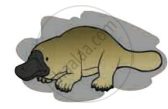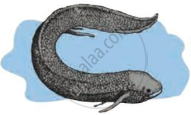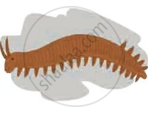Advertisements
Advertisements
प्रश्न
Vestigial organ ______ present in human body is proof of evolution.
विकल्प
Human hand
Appendix
Ear muscles
Tail-bone
Gradual development
Mutation
Gene
Transcription
Translocation
उत्तर
Vestigial organ appendix present in human body is proof of evolution.
Explanation:
Appendix, which is useless to human, is useful and fully functional organ in ruminants. Similarly, muscles of ear pinna, which are useless to human, are useful in monkeys for movement of ear pinna. Various vestigial organs like tail-bone (coccyx), wisdom teeth, and body hairs are present in body of human being.
Notes
Above question has three possible answers, [Option (B), (C) and (D)].
संबंधित प्रश्न
Mammals : _________ : : Amphibia : Fishes
(a) Select the analogous structures from the combination given below:
(i) Forelimbs of whales and bats
(ii) Eyes of octopus and mammals
(iii) Tuber of sweet potato and potato
(iv) Tuber of Bougainvillea and tendrils of Cucurbita
(b) State the kind of evolution they represent
Given below is the list of vegetables available in the market. Select from these the two vegetables having homologous structures:
Potato, sweet potato, ginger, radish, tomato, carrot, okra (Lady’s finger)
(A) Potato and sweet potato
(B) Radish and carrot
(C) Okra and sweet potato
(D) Potato and tomato
Select two pairs from the following which exhibit divergent evolution. Give reasons for your answer.
(i) Forelimbs of cheetah and mammals
(ii) Flippers of dolphins and penguins
(iii) Wings of butterflies and birds
(iv) Forelimbs of whales and mammals
An example of homologous organs is
Explain with an example for the given, how the following provides evidence in favor of evolution in organisms :
Fossils
Explain the evolution of giraffe's neck according to Lamarck's theory of evolution.
Select and write analogous structures from the list given below :
1) Wings of butterfly and birds
2) Vertebrate hearts
3) Tendrils of Bougainvillea and Cucurbita
4) Tubers of sweet potato and potato
Out of bacteria, spider, fish and chimpanzee, which organism has a better body design in evolutionary terms? Give reason for your answer.
The presence of which of the following types of organs in two organisms indicates that they are derived from the same ancestor?
(a) analogous organs
(b) respiratory organs
(c) digestive organs
(d) homologous organs
X, Y, and Z are three animals. The animal X can fly but animal Y can only run on ground or walls. The forelimbs of animals X and Y have the same basic design but they are used for different purposes such as flying and running respectively. The animal Z became extinct an long time ago. The study of fossils of Z tells us that it had some features like those of X and some like those of Y. In fact, Z is said to form a connecting link in the evolutionary chain of X and Y.
(a) What could the animals X, Y and Z be?
(b) What name is given to the forelimbs like those of X and Y which have the same basic design but different functions?
(c) Name one feature in which Z resembled X.
(d) Name one feature in which Z resembled Y.
(e) Which is the correct evolutionary chain involving X, Y and Z : X → Z → Y or Y → Z → X?
Read the following statement and justify same in your own words with the help of suitable example.
There is evidences of fatal science among chordates.
Write the names of those animals in whom the human body organs are functioning.
Explain with suitable examples importance of anatomical evidence in evolution.
_______ is a connecting link between Annelida and Arthropoda.
Differentiate between connecting links and the missing links.
Find an odd one out.
Find an odd one out.
Name the parts shown in the diagram.
Human jaw

Match the following.
| Column A | Column B |
| 1) Morphological evidences | a) Tail-bone or wisdom teeth |
| 2) Paleontological evidences | b) Leaf venation |
| c) Fossils |
Give scientific reason.
Vertebrates have slowly originated from invertebrates.
Give scientific reason.
Duck-billed platypus shows relationship with mammals.
What is carbon dating?
Write the answers to the questions by observing the figure below.
 |
 |
 |
| (a) | (b) | (c) |
- Write the name of the animal ‘(a)’ in the figure.
- Write the name of the animal ‘(b)’ in the figure.
- Write the name of the animal ‘(c)’ in the figure.
- Which evolutionary evidence is illustrated by this figure?
- Write the definition of that evidence for evolution.
Select the CORRECT match.
- Define vestigial organs.
- Write names of any two vestigial organs in the human body.
- Write name of those animals in which these vestigial organs are functional.
Basic principles of embryonic development were pronounced by:
Analogous organs arise due to ______.
Did aquatic life forms get fossilised? If, yes where do we come across such fossils?
What are we referring to? When we say 'simple organisms' or 'complex organisms'.
Give an example for convergent evolution and identify the features towards which they are converging.
Explain divergent evolution in detail. What is the driving force behind it?
As shown in figure below some organisms that share a common ancestor have features that have different functions, but similar structures.

These are known as ______. Give example.
Write down the difference between homologous and analogous organs.
Write a note on the significance of Palaeontology.
Industrial melanism in England after 1850 is an excellent example of Natural selection. Explain how?
